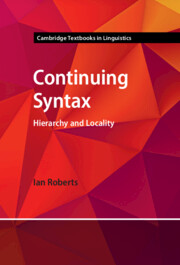Book contents
- Continuing Syntax
- Cambridge Textbooks in Linguistics
- Continuing Syntax
- Copyright page
- Contents
- Preface
- Abbreviations
- Part I Configuration and Hierarchy
- 1 Goals and Basic Assumptions
- 2 Hierarchy I: Phrase Structure and Grammatical Functions
- 3 Hierarchy II: C-Command, Head-Movement and Locality
- 4 Hierarchy and Categories I: Refining the Structure of the Clause and the VP
- 5 Hierarchy and Categories II: The Structure of Nominals
- 6 Case and the Nature of Infinitives
- 7 Features, Case and Agreement
- 8 Hierarchy and Linear Order
- 9 The Origins of Hierarchy: Bare Phrase Structure
- Part II Locality
- Glossary
- Book part
- Index
- References
3 - Hierarchy II: C-Command, Head-Movement and Locality
from Part I - Configuration and Hierarchy
Published online by Cambridge University Press: 03 October 2025
- Continuing Syntax
- Cambridge Textbooks in Linguistics
- Continuing Syntax
- Copyright page
- Contents
- Preface
- Abbreviations
- Part I Configuration and Hierarchy
- 1 Goals and Basic Assumptions
- 2 Hierarchy I: Phrase Structure and Grammatical Functions
- 3 Hierarchy II: C-Command, Head-Movement and Locality
- 4 Hierarchy and Categories I: Refining the Structure of the Clause and the VP
- 5 Hierarchy and Categories II: The Structure of Nominals
- 6 Case and the Nature of Infinitives
- 7 Features, Case and Agreement
- 8 Hierarchy and Linear Order
- 9 The Origins of Hierarchy: Bare Phrase Structure
- Part II Locality
- Glossary
- Book part
- Index
- References
Summary
In this chapter we continue our investigation of hierarchy by looking at head-movement, i.e. how heads of phrases may move and combine. In addition to seeing how this kind of movement works in technical terms, and what the empirical motivation for it is, we also introduce a major locality condition, the Head Movement Constraint. Then we return briefly to the topic of passives, and introduce raising. Finally, we make a first attempt at formulating a general notion of locality which unifies the Head Movement Constraint with a locality condition applying to both passives and raising.
Information
- Type
- Chapter
- Information
- Continuing SyntaxHierarchy and Locality, pp. 55 - 75Publisher: Cambridge University PressPrint publication year: 2025
References
Further Reading
Accessibility standard: WCAG 2.2 AAA
Content Navigation
Allows you to navigate directly to chapters, sections, or non‐text items through a linked table of contents, reducing the need for extensive scrolling.
Provides an interactive index, letting you go straight to where a term or subject appears in the text without manual searching.
Reading Order & Textual Equivalents
You will encounter all content (including footnotes, captions, etc.) in a clear, sequential flow, making it easier to follow with assistive tools like screen readers.
You get concise descriptions (for images, charts, or media clips), ensuring you do not miss crucial information when visual or audio elements are not accessible.
You get more than just short alt text: you have comprehensive text equivalents, transcripts, captions, or audio descriptions for substantial non‐text content, which is especially helpful for complex visuals or multimedia.
Visual Accessibility
You will still understand key ideas or prompts without relying solely on colour, which is especially helpful if you have colour vision deficiencies.
You benefit from high‐contrast text, which improves legibility if you have low vision or if you are reading in less‐than‐ideal lighting conditions.
